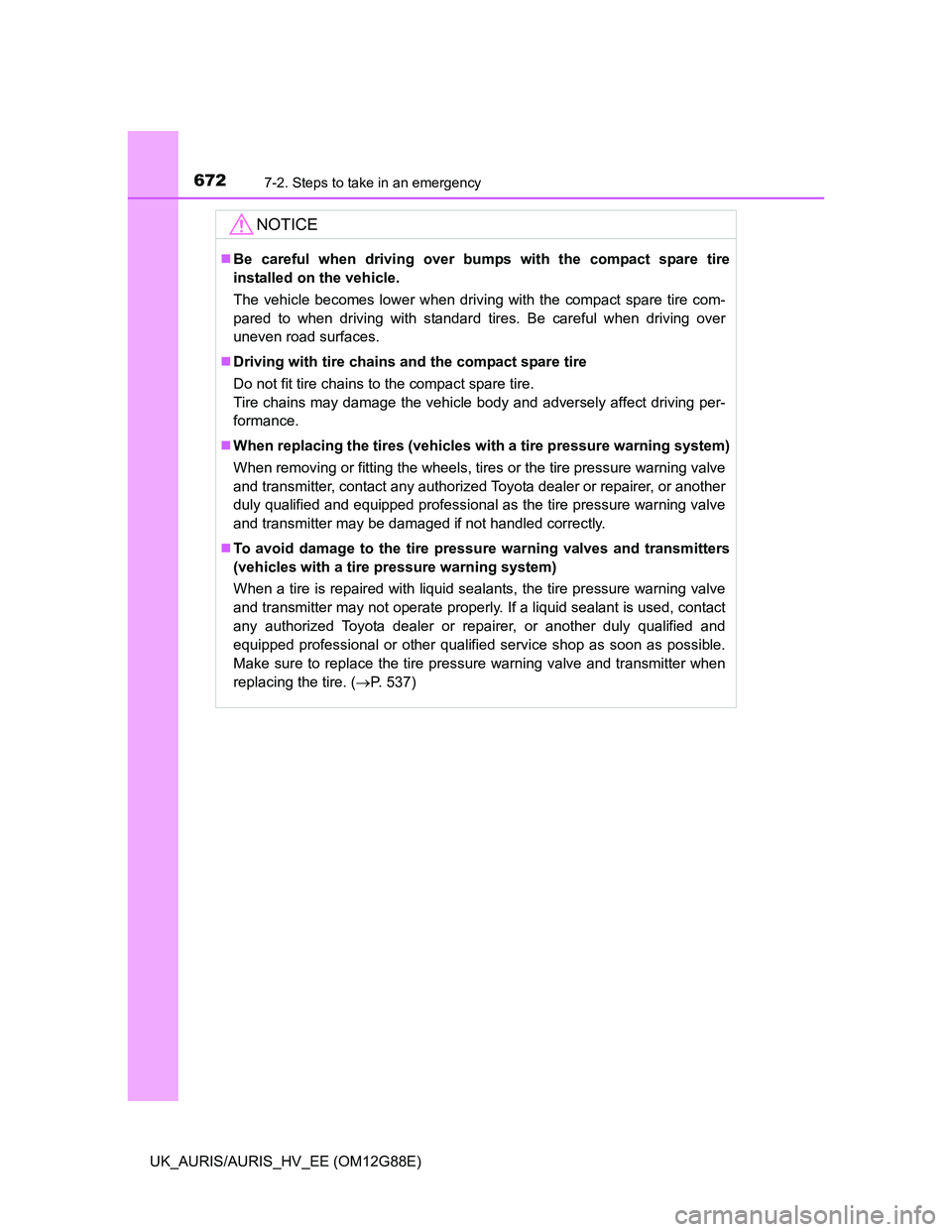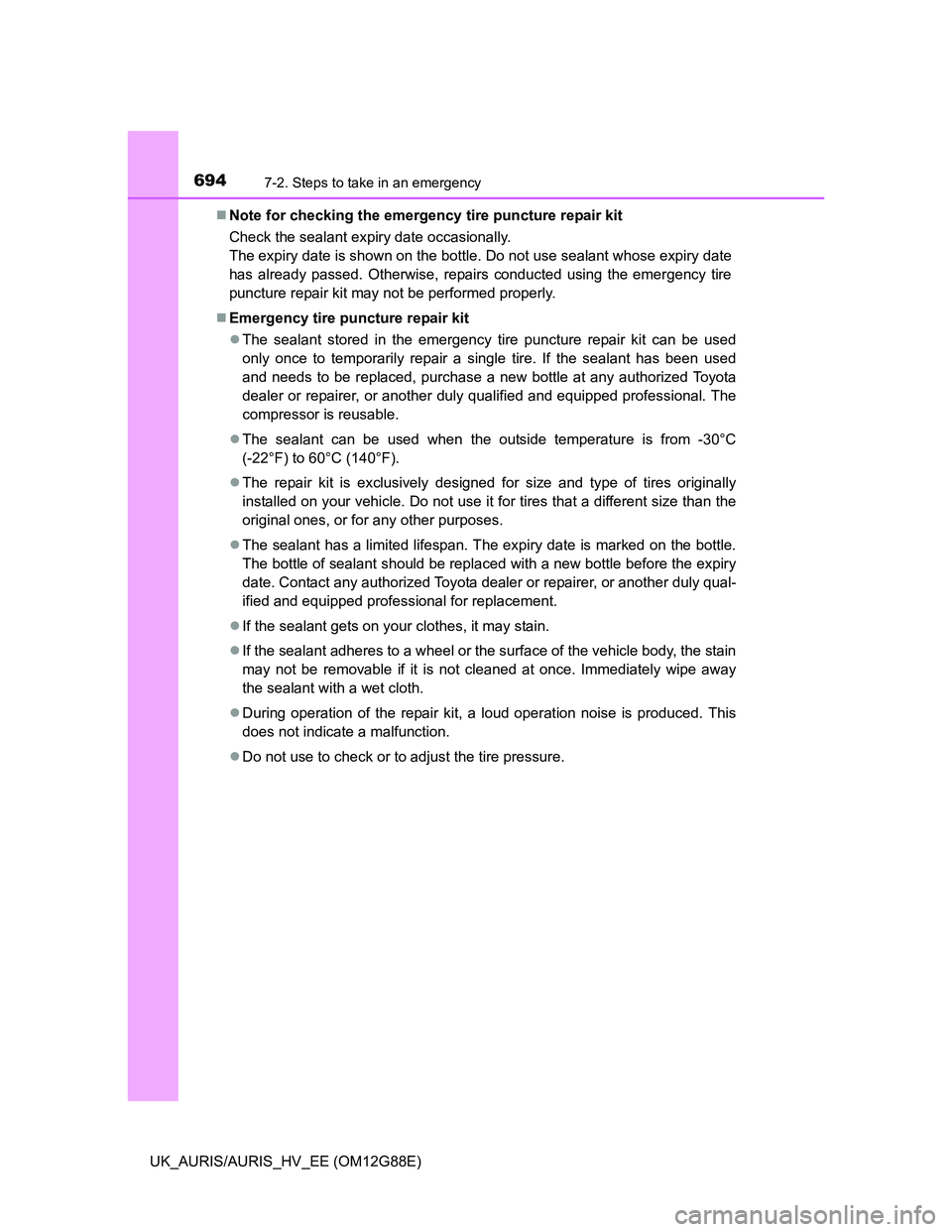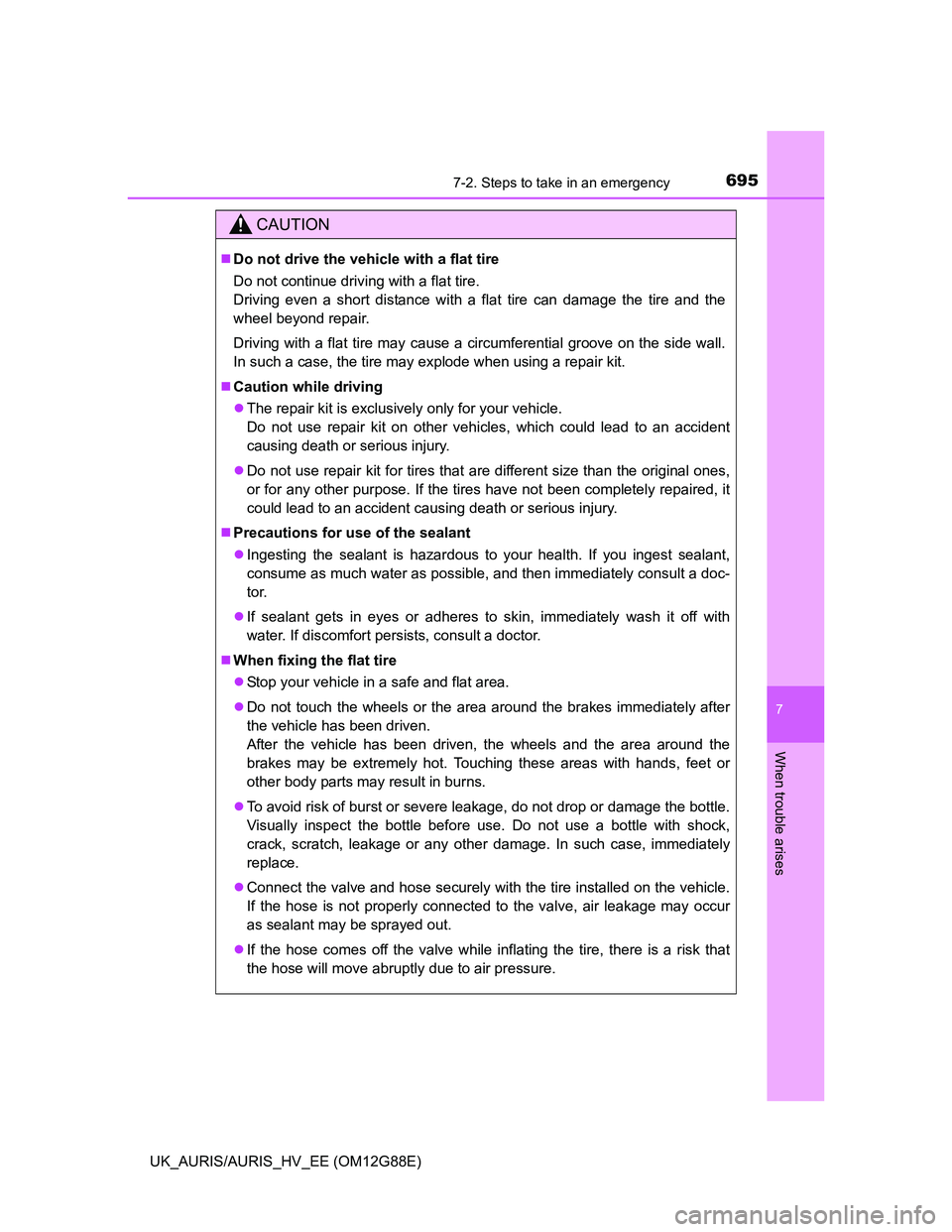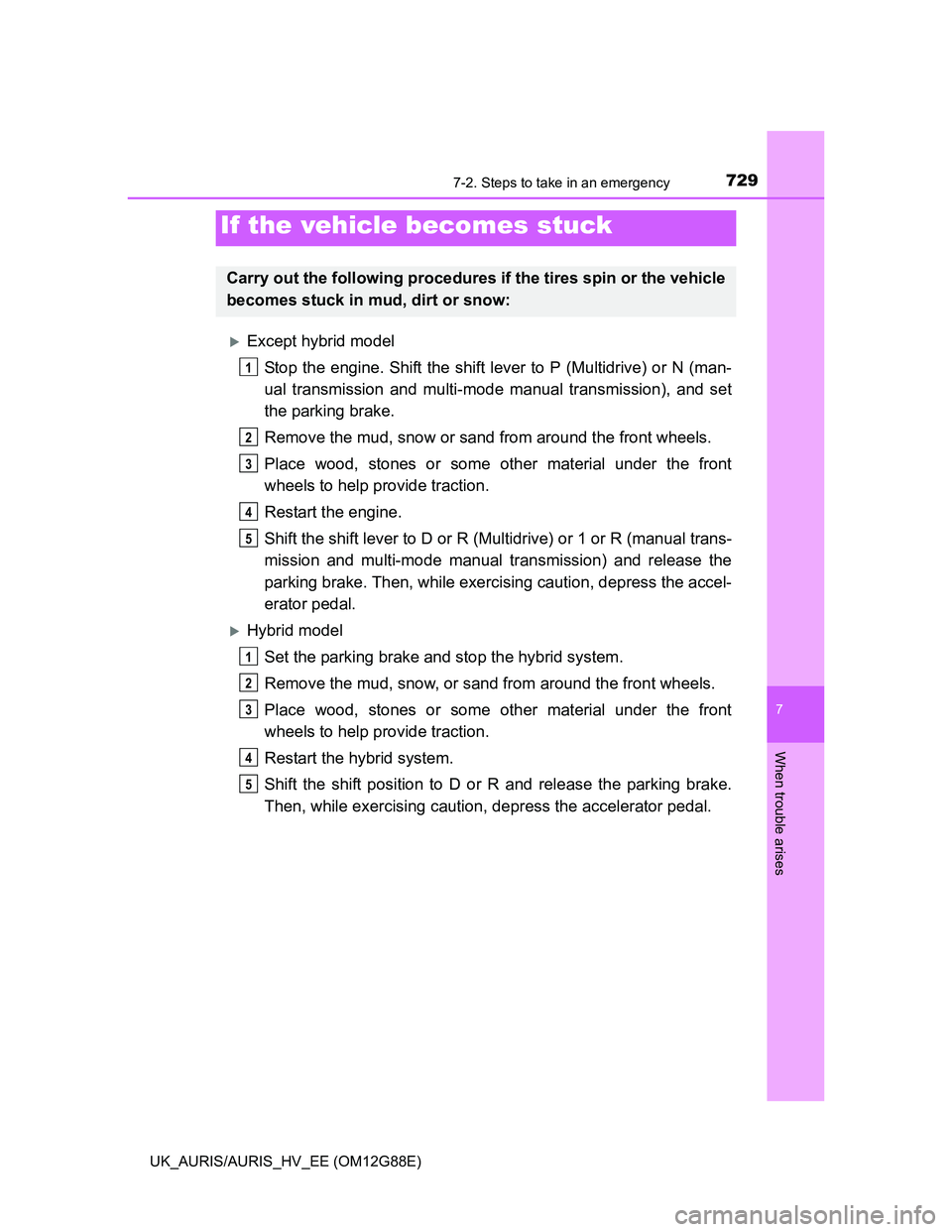Page 672 of 788

6727-2. Steps to take in an emergency
UK_AURIS/AURIS_HV_EE (OM12G88E)
NOTICE
Be careful when driving over bumps with the compact spare tire
installed on the vehicle.
The vehicle becomes lower when driving with the compact spare tire com-
pared to when driving with standard tires. Be careful when driving over
uneven road surfaces.
Driving with tire chains and the compact spare tire
Do not fit tire chains to the compact spare tire.
Tire chains may damage the vehicle body and adversely affect driving per-
formance.
When replacing the tires (vehicles with a tire pressure warning system)
When removing or fitting the wheels, tires or the tire pressure warning valve
and transmitter, contact any authorized Toyota dealer or repairer, or another
duly qualified and equipped professional as the tire pressure warning valve
and transmitter may be damaged if not handled correctly.
To avoid damage to the tire pressure warning valves and transmitters
(vehicles with a tire pressure warning system)
When a tire is repaired with liquid sealants, the tire pressure warning valve
and transmitter may not operate properly. If a liquid sealant is used, contact
any authorized Toyota dealer or repairer, or another duly qualified and
equipped professional or other qualified service shop as soon as possible.
Make sure to replace the tire pressure warning valve and transmitter when
replacing the tire. (P. 537)
Page 678 of 788

6787-2. Steps to take in an emergency
UK_AURIS/AURIS_HV_EE (OM12G88E)
Check the degree of the tire dam-
age.
• Do not remove the nail or screw
from the tire. Removing the
object may widen the opening
and prevent emergency repair
with the repair kit.
• Type A: To avoid sealant leak-
age, move the vehicle until the
area of the puncture, if known,
is positioned at the top of the
tire.
In the following cases, the tire cannot be repaired with the emergency
tire puncture repair kit. Contact any authorized Toyota dealer or repairer,
or another duly qualified and equipped professional.
When the tire is damaged due to driving without sufficient air pressure
When there are any cracks or damage at any location on the tire, such as on
the side wall, except the tread
When the tire is visibly separated from the wheel
When the cut or damage to the tread is 4 mm (0.16 in.) long or more
When the wheel is damaged
When two or more tires have been punctured
When 2 or more sharp objects such as nails or screws have passed through
the tread on a single tire
When the sealant has expired
Before performing emergency repair
Page 694 of 788

6947-2. Steps to take in an emergency
UK_AURIS/AURIS_HV_EE (OM12G88E)Note for checking the emergency tire puncture repair kit
Check the sealant expiry date occasionally.
The expiry date is shown on the bottle. Do not use sealant whose expiry date
has already passed. Otherwise, repairs conducted using the emergency tire
puncture repair kit may not be performed properly.
Emergency tire puncture repair kit
The sealant stored in the emergency tire puncture repair kit can be used
only once to temporarily repair a single tire. If the sealant has been used
and needs to be replaced, purchase a new bottle at any authorized Toyota
dealer or repairer, or another duly qualified and equipped professional. The
compressor is reusable.
The sealant can be used when the outside temperature is from -30°C
(-22°F) to 60°C (140°F).
The repair kit is exclusively designed for size and type of tires originally
installed on your vehicle. Do not use it for tires that a different size than the
original ones, or for any other purposes.
The sealant has a limited lifespan. The expiry date is marked on the bottle.
The bottle of sealant should be replaced with a new bottle before the expiry
date. Contact any authorized Toyota dealer or repairer, or another duly qual-
ified and equipped professional for replacement.
If the sealant gets on your clothes, it may stain.
If the sealant adheres to a wheel or the surface of the vehicle body, the stain
may not be removable if it is not cleaned at once. Immediately wipe away
the sealant with a wet cloth.
During operation of the repair kit, a loud operation noise is produced. This
does not indicate a malfunction.
Do not use to check or to adjust the tire pressure.
Page 695 of 788

6957-2. Steps to take in an emergency
UK_AURIS/AURIS_HV_EE (OM12G88E)
7
When trouble arises
CAUTION
Do not drive the vehicle with a flat tire
Do not continue driving with a flat tire.
Driving even a short distance with a flat tire can damage the tire and the
wheel beyond repair.
Driving with a flat tire may cause a circumferential groove on the side wall.
In such a case, the tire may explode when using a repair kit.
Caution while driving
The repair kit is exclusively only for your vehicle.
Do not use repair kit on other vehicles, which could lead to an accident
causing death or serious injury.
Do not use repair kit for tires that are different size than the original ones,
or for any other purpose. If the tires have not been completely repaired, it
could lead to an accident causing death or serious injury.
Precautions for use of the sealant
Ingesting the sealant is hazardous to your health. If you ingest sealant,
consume as much water as possible, and then immediately consult a doc-
tor.
If sealant gets in eyes or adheres to skin, immediately wash it off with
water. If discomfort persists, consult a doctor.
When fixing the flat tire
Stop your vehicle in a safe and flat area.
Do not touch the wheels or the area around the brakes immediately after
the vehicle has been driven.
After the vehicle has been driven, the wheels and the area around the
brakes may be extremely hot. Touching these areas with hands, feet or
other body parts may result in burns.
To avoid risk of burst or severe leakage, do not drop or damage the bottle.
Visually inspect the bottle before use. Do not use a bottle with shock,
crack, scratch, leakage or any other damage. In such case, immediately
replace.
Connect the valve and hose securely with the tire installed on the vehicle.
If the hose is not properly connected to the valve, air leakage may occur
as sealant may be sprayed out.
If the hose comes off the valve while inflating the tire, there is a risk that
the hose will move abruptly due to air pressure.
Page 729 of 788

7297-2. Steps to take in an emergency
UK_AURIS/AURIS_HV_EE (OM12G88E)
7
When trouble arises
Except hybrid model
Stop the engine. Shift the shift lever to P (Multidrive) or N (man-
ual transmission and multi-mode manual transmission), and set
the parking brake.
Remove the mud, snow or sand from around the front wheels.
Place wood, stones or some other material under the front
wheels to help provide traction.
Restart the engine.
Shift the shift lever to D or R (Multidrive) or 1 or R (manual trans-
mission and multi-mode manual transmission) and release the
parking brake. Then, while exercising caution, depress the accel-
erator pedal.
Hybrid model
Set the parking brake and stop the hybrid system.
Remove the mud, snow, or sand from around the front wheels.
Place wood, stones or some other material under the front
wheels to help provide traction.
Restart the hybrid system.
Shift the shift position to D or R and release the parking brake.
Then, while exercising caution, depress the accelerator pedal.
If the vehicle becomes stuck
Carry out the following procedures if the tires spin or the vehicle
becomes stuck in mud, dirt or snow:
1
2
3
4
5
1
2
3
4
5
Page 733 of 788
7338-1. Specifications
UK_AURIS/AURIS_HV_EE (OM12G88E)
8
Vehicle specifications
*1: Unladen vehicles
*2: Vehicles with 195/65R15 tires
*3: Vehicles with 205/55R16 tires
*4: Vehicles with 215/45R17 tires
*5: Vehicles with 225/45R17 tires
*6: Vehicles with a Multidrive
*7: Vehicles with a manual transmission
Maximum
permissible axle
capacityFront
1NR-FE, 1ZR-FAE and 1ND-TV
engines
1020 kg (2249 lb.)
1AD-FTV engine
1080 kg (2381 lb.)
Rear 1010 kg (2227 lb.)
Drawbar load
1NR-FE and 1ND-TV engines
55 kg (121 lb.)
1ZR-FAE engine
65 kg (143 lb.)
1AD-FTV engine
72 kg (159 lb.)
Towing capacityWith brake
1NR-FE and 1ND-TV engines
1000 kg (2205 lb.)
1ZR-FAE engine
1300 kg (2867 lb.)
1AD-FTV engine
1500 kg (3308 lb.)
Without brake 450 kg (992 lb.)
Page 734 of 788
7348-1. Specifications
UK_AURIS/AURIS_HV_EE (OM12G88E)
Hybrid model
*1: Unladen vehicles
*2: Vehicles with 195/65R15 tires
*3: Vehicles with 205/55R16 tires
*4: Vehicles with 225/45R17 tires
*5: ZWE186L-DHXGBW, ZWE186R-DHXGBW models*8
*6: ZWE186L-DHXNBW, ZWE186R-DHXNBW models*8
*7: Vehicles with towing package
*8: The model code is indicated on the manufacturer's label. (P. 735)
Overall length 4275 mm (168.3 in.)
Overall width 1760 mm (69.3 in.)
Overall height*11460 mm (57.5 in.)
Wheelbase 2600 mm (102.4 in.)
Tread
Front1535 mm (60.4 in.)
*2
1525 mm (60.0 in.)*3
1515 mm (59.6 in.)*4
Rear1530 mm (60.2 in.)
*2
1515 mm (59.6 in.)*3
1505 mm (59.3 in.)*4
Gross vehicle mass1840 kg (4057 lb.)*5
1815 kg (4002 lb.)*6
Maximum permis-
sible axle capacityFront 1020 kg (2249 lb.)
Rear 1010 kg (2227 lb.)
Drawbar load*755 kg (121 lb.)
Towing capacity*7385 kg (848 lb.)
Page 750 of 788
7508-1. Specifications
UK_AURIS/AURIS_HV_EE (OM12G88E)
Ty p e A
*1: “For optimizing fuel economy, ECO tire pressure is recommended. Tire
pressure affects traveling comfort, road noise and steering characteristics.”
*2: Hybrid model (with ECO tire pressure label)
*3: 1ND-TV engine (with ECO tire pressure label)
Tires and wheels
Tire size195/65R15 91H
Tire inflation pres-
sure
(Recommended
cold tire inflation
pressure)
Vehicle speed
Front wheel
kPa (kgf/cm2
or bar, psi)
Rear wheel
kPa (kgf/cm2
or bar, psi)
More than 160
km/h (100 mph)260 (2.6, 38)260 (2.6, 38)
Normal pressure:
160 km/h (100
mph) or less
230 (2.3, 33)230 (2.3, 33)
ECO pressure*1:
160 km/h (100
mph) or less250 (2.5, 36)*2
260 (2.6, 38)*2
270 (2.7, 39)*3
250 (2.5, 36)*2
250 (2.5, 36)*2
260 (2.6, 38)*3
Wheel size15 6 J
Wheel nut torque103 N•m (10.5 kgf•m, 76 ft•lbf)